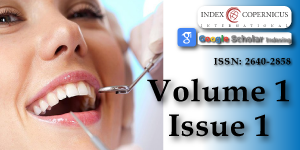“Bulls Eye For Bulls Teeth”- Endodontic Management of Taurodontism Using CBCT as A Diagnostic Tool- 2 Rare Case Reports
Main Article Content
Abstract
Taurodontism is a rare dental anomaly presented with an aberration of teeth that lacks the constriction at the level of the cemento-enamel junction (CEJ). It is characterized by elongated pulp chambers and apical displacement of bifurcation or trifurcation of the roots, forming a rectangular shape. Whilst, it appears most frequently as an isolated anomaly, its association with several syndromes and abnormalities has also been reported in the literature. Although permanent molars are most commonly affected, this anomaly could also be seen in deciduous dentition, unilaterally or bilaterally, and in any combination of teeth or quadrants. These morphological anomalies pose various challenges to the dentist during their endodontic treatment. Modern diagnostic tools such as Cone beam computed tomography (CBCT), loupes and Dental operating microscopes (DOM) help in achieving better treatment outcome in such cases. The presented article elaborates diagnosis and successful management of 2 rare cases of taurodontism in permanent molars.
Article Details
Copyright (c) 2017 Sonkurla S, et al.

This work is licensed under a Creative Commons Attribution 4.0 International License.
Neville BW, Damm DD, Allen CM, Bouquot JE. Oral & Maxillofacial Pathology. 5th edn. Philadelphia: WB Saunders, 2002.
Jafarzadeh H, Azarpazhooh A, Mayhall JT. Taurodontism: a review of the condition and Endodontic treatment challenges. Int Endod J. 2008; 41: 375-388. Ref.: https://goo.gl/0gDJN4
Durr DP, Campos CA, Ayers CS. Clinical significance of taurodontism. J Am Dent Assoc. 1980; 100: 378-381. Ref.: https://goo.gl/OGlZtw
Llamas R, Jimenez-Planas A. Taurodontism in premolar. Oral Surg Oral Med Oral Pathol.1993; 75: 501-505. Ref.: https://goo.gl/qUP2AO
Jaspers MT. Taurodontism in the Down syndrome. Oral Surg Oral Med Oral Pathol. 1981; 51: 632-636. Ref.: https://goo.gl/su5B80
Schulman GS, Redford-Badwal D, Poole A, Mathieu G, Burleson J, et al. Taurodontism and learning disabilities. In patients with Klinefelter syndrome. Pediatr Dent. 2005; 27: 389-394. Ref.: https://goo.gl/6cPfNd
Gros CI, Clauss F, Obry F, Manière MC, Schmittbuhl M, et al. Quantification of taurodontism: interests in the early Diagnosis of hypohidrotic ectodermal dysplasia. Oral Dis. 2010; 16: 292-298. Ref.: https://goo.gl/F6FVzh
Tomona N, Smith AC, Guadagnini JP, Hart TC. Craniofacial and dental phenotype of Smith-Magenis syndrome. Am J Med Genet A. 2006; 140: 2556-2561. Ref.: https://goo.gl/GrO7ae
Hazza’a AM, Al-Jamal G. Radiographic features of the jaws and teeth in thalassaemia major. Dentomaxillofac Radiol. 2006; 35: 283-288. Ref.: https://goo.gl/twPlw1
Nguyen T, Phillips C, Frazier-Bower S, Wright T. Craniofacial variations in the tricho-dento-osseous syndrome. Clin Genet. 2013; 83: 375-379. Ref.: https://goo.gl/P8Ta4r
Al jamal GA, Hazza’a AM, Rawashdeh MA. Prevalence of dental anomalies in a population of cleft lip and palate patients. Cleft Palate Craniofac J. 2010; 47: 413-420. Ref.: https://goo.gl/orxMMe
Nawa H, Oberoi S, Vargervik K. Taurodontism and Van der Woude syndrome. Is there an association? Angle Orthod. 2008; 78: 832-837. Ref.: https://goo.gl/yGJEHd
Shaw JC. Taurdont teeth in South African races. J Anat. 1928; 62: 476-498. Ref.: https://goo.gl/bkCUO3
Goaz PW, White SC. Oral mRadiology (Principle and interpretation), 3rd edn St. Louis, Missouri: CV. Mosby Year Book Inc. 1994.
Kosinski RW, Chaiyawat Y, Rosenberg L. Localized deficient root development associated with Taurodontism: case report. Pediatr Dent. 1999; 21: 213-215. Ref.: https://goo.gl/lYjK5Z
Shifman A, Chanannel I. Prevalence of taurodontism found in radiographic dental Examination of 1,200 young adult Israeli patients. Community Dent Oral Epidemiol. 1978; 6: 200-203. Ref.: https://goo.gl/RlxFPK
Radwan A, Kim SG. Treatment of a Hypertaurodontic Maxillary Second Molar in a Patient with 10 Taurodonts: A Case Report. J Endod. 2014; 40: 140-144. Ref.: https://goo.gl/DK8yd2
Kavita Verma, Kapil Loomba, Rhythm Bains. Endodontic Management of a Hypertaurodont Maxillary First Molar Asian Journal of Oral Health & Allied Sciences 2012; 101-103.
Simsek N, Keles A, Ocak MS. Endodontic treatment of hypertaurodontism with multiple bilateral Taurodontism. J Conserv Dent. 2013; 16: 477-479. Ref.: https://goo.gl/zjtPPx
Santosh R Patil, Aileni Kaladhar Reddy J. Dental Research and Review 2015; 34-36.
Joseph M. Endodontic treatment in three taurodontic teeth associated with 48, XXXY Klinefeltor syndrome: A review and case report. Oral Surg Oral Med Oral Path Oral Radiol Endod. 2008; 105: 670-677. Ref.: https://goo.gl/9jlwrF
Dineshshankar J, Sivakumar M, Balasubramanium AM, Kesavan G, Karthikeyan M, et al. Taurodontism. J Pharm Bioallied Sci. 2014; 6: 13-15. Ref.: https://goo.gl/92X5Cq
Genc A, Namdar F, Goker K, Atasu M. Taurodontism in association with super numerary teeth. J Clin Pediatr Dent. 1999; 23: 151-154. Ref.: https://goo.gl/3Pv47u
Gedik R, Cimen M. Multiple Taurodontism: Report of a case. ASDC J Dent Child. 2000; 67: 216-217. Ref.: https://goo.gl/nNQjSe
MacDonald-Jankowski DS, Li TT. Taurodontism in a young adult chinese population. DentoMaxillofac Radiol. 1993; 22: 140-144. Ref.: https://goo.gl/uW4oRv
Tiku A, Damle SG, Nadkarni UM, Kalaskar RR. Hypertaurodontism in molars and premolars: Management of two rare cases. J Indian Soc Pedod Prev Dent. 2003; 21: 131-134. Ref.: https://goo.gl/pFIYKA
Varrela J, Alvesalo L, Mayhall J. Taurodontism in 45, X females. J Dent Res. 1990; 69: 494-495. Ref.: https://goo.gl/uIs3CK

